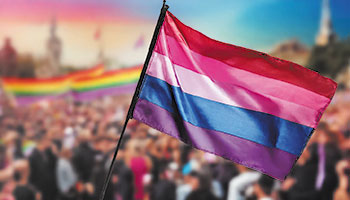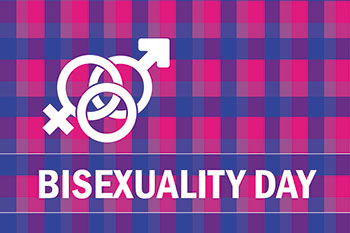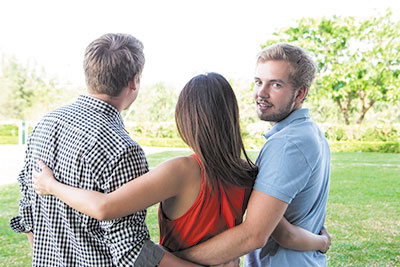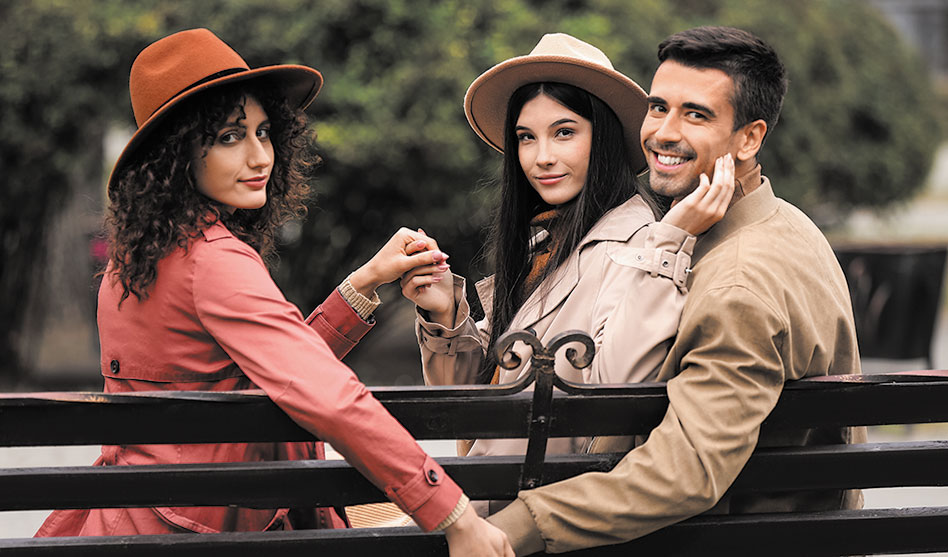Even though the ‘B’ comes third in ‘LGBTQ,’ bisexuals often face discrimination from within and outside of the LGBTQ community
CAROLINE SAVOIE | Contributing Writer
carolinelsavoie@gmail.com
EDITOR’S NOTE: Bisexual Awareness Week is Sept. 16-23, culminating in Celebrate Bisexuality+ Day on Sept. 23. In this article, Dallas Voice examines the biphobia often found in the LGBTQ community.
Studies across the world have shown that bisexual humans, and especially bisexual women, face unique challenges within the LGBTQ community, and personal experiences described by bi people back those studies up.
In 2022, Jayna Tavarez studied nine bisexual students engaged in LGBTQ spaces on a college campus. The participants all experienced bisexual-specific stress within LGBTQ spaces, the report said.
There’s a popular discourse online and in LGBTQ spaces when it comes to desirability of bisexual women within and outside of the LGBTQ community. Sex researcher Zhana Vrangalova, writing for Julie E. Hartman’s study Another Kind of ‘Chilly Climate:’ The Effects of Lesbian Separatism on Identity and Community, noted, “Lesbian women and communities are notorious for rejecting bisexual women as potential friends and as sexual and romantic partners due to stereotypes that bisexual women are untrustworthy, unreliable, incapable of monogamy, disease carriers and ‘sleeping with the enemy.’”
 Brian Kennedy, an LGBTQ-affirming therapist at Room for Change in Oak Lawn who identifies as gay, said that during the coming out process, LGBTQ humans can go through a phase where they reject heteronormativity as a way of turning anger outward.
Brian Kennedy, an LGBTQ-affirming therapist at Room for Change in Oak Lawn who identifies as gay, said that during the coming out process, LGBTQ humans can go through a phase where they reject heteronormativity as a way of turning anger outward.
“Sometimes biphobia shows up because there is a misconception of bisexuals as half-gay, half-straight, and there is a rejection of the perceived heterosexual part,” Kennedy said.
He continued by saying that in society, “There is a desire for others to be like us.”
“These misconceptions about bisexuality can stem from wanting others to identify like ourselves to validate our identities instead of dating others that appear to uphold heteronormative ideals,” Kennedy said. “I would encourage people with that belief to explore where it comes from — [determine] if it comes from insecurity or negative messaging in culture that forms our cognitions about self.”
Vrangalova said bisexual men are stigmatized by gay men to some extent. But because of gay men’s lesser cultural emphasis on monogamy, how much bisexual men are desired by potential partners is less affected by these stereotypes.
Kennedy noted that oftentimes when men identify as bisexual, people think they’re not really bi, “they’re just not all the way out yet.”
Another study — Bisexual prejudice among lesbian and gay people: Examining the roles of gender and perceived sexual orientation, — suggests that these stereotypes could be due to what researchers call the androcentric desire hypothesis: the idea that people perceive bisexuals as being more sexually attracted to men than they are to women.
“Indeed, the stereotypical perception of a bisexual man is often a ‘gay man in denial,’ but the stereotypical perception of a bisexual woman is a ‘heterosexual in disguise’ who’s hooking up with women temporarily for ‘fun,’ or to attract the attention of straight men,” Vrangalova wrote regarding Harman’s study.
 Tamera Lanay, a 28-year-old Dallas resident and queer woman who uses she/they pronouns, said that while she hasn’t experienced feeling ostracized in the LGBTQ dating scene, she has felt objectified by the straight men she dates.
Tamera Lanay, a 28-year-old Dallas resident and queer woman who uses she/they pronouns, said that while she hasn’t experienced feeling ostracized in the LGBTQ dating scene, she has felt objectified by the straight men she dates.
“I’ve faced a lot of fetishization from straight men who are interested in dating,” Lanay said. “[Straight men] often ask if I would want to engage in a threesome. They almost feel like I’m an object. They assume that I don’t want to date women, that I just want to have sex with women.”
“They don’t have the maturity to understand what my sexuality really is,” they continued. “It’s off-putting and disheartening. I’d love for them to have more of an understanding.”
In both examples, the sexuality of bisexual women and men is perceived as oriented mainly toward men.
In the study by Matsick and Rubin, 165 lesbian women and gay men in undergraduate school were asked to answer questions about how they feel their group — lesbians or gay men — viewed bisexual women or men and to what extent they thought bisexuals were attracted to men or women.
“Confirming past research,” Vrangalova wrote in Hartman’s study, “lesbian women were more negative toward bisexuals than were gay men, and they were more negative toward bisexual women than gay men were toward bisexual men, in particular.”
Lanay suggested that this is an example of the patriarchy at play.
“Even though we live in a society that is more accepting of the LGBTQ community, I still feel like maleness and gay men are still centered in that,” they said. “We know when it comes to the trans community, they face erasure and far more oppression. When it comes to bisexual women and dating, it’s hard.”
Vrangalova continued, “Furthermore, the results mostly supported the androcentric desire hypothesis. Lesbian and gay participants both agreed that bisexual men are significantly more attracted to men than they are to women, and lesbian women felt that this was true of bisexual women as well.
The only exception to this pattern were gay men who felt bisexual women were equally attracted to men and women.”
Lanay said that she does worry about facing judgment when dating femmes: “For a lot of queer women, there’s this concern that I might face judgment because I’m not as experienced with women,” they said.
 In June 2024, a discourse on TikTok arose around bisexual women bringing their straight boyfriends to Pride events.
In June 2024, a discourse on TikTok arose around bisexual women bringing their straight boyfriends to Pride events.
Some lesbian women felt that bringing a straight person to Pride infringes upon the safe space Pride provides members of the LGBTQ community. Other creators pushed back, saying that any person who supports the community and loves its members should be allowed at Pride.
Lanay said that rhetoric like this further divides the community during a time where it must band together: “I think that response from Sapphics pushing back on queer women bringing straight partners to Pride is the exact reason some feel ostracized or judged in the community,” they said. “I think it gives into this black-and-white thinking. If someone’s straight partner is an ally, isn’t that what Pride is about?
“We live in the state of Texas, where anti-trans or anti-LGBTQ laws have been passed in our legislature,” they added. “To further divide our community is an injustice considering the oppression we’re up against. We need community; we need to accept others.”
Kennedy said that he believes exposure and visibility is something that helps the LGBTQ community.
“When we silo off, we’re not doing anybody a service,” he said. “I know we haven’t always been allowed to be ourselves in public spaces, but I also believe that when we separate ourselves from the rest of society, that’s when stereotypes prevail.
We need to be seen to be understood.”
He said that if he were to speak to someone with the belief that straight people don’t belong at Pride, he would approach them with curiosity: “What is the irrational belief you’re attaching to that behavior?” he said he’d ask. “Is it because they’re in that place that is not accepting of anything heterosexual? I’d ask, ‘Why is that coming up for you?”
Kennedy said that he would encourage the community to bring straight allies to Pride if they’re respectful, so those people can go back into their circles and influence others.
There’s another unique challenge bisexual humans face: feeling like they have to “prove” their queerness if they’re in a relationship with someone of the opposite gender. Because their sexuality is not obvious to the rest of the world, it can feel like their queerness is minimized.
“When I’m in straight spaces, people tend to assume that I’m straight,” Lanay said. “That’s when I feel like I’m not seen in my fullness. I don’t like when someone assumes I’m straight.”
Kennedy said that in society, we’ve been indoctrinated to believe that seeing a man and a woman in partnership “equals straight, not bi.”
“We’re constantly challenged with our identity in a heteronormative society. Know who you are, be okay with who you are and who you want, and at the end of the day the rest is no one else’s business,” he said. “You don’t need popular opinion on your identity. You’re gonna hear negative things, as our own culture and community is steeped in stigma.”
Lanay said they have found two spaces in Dallas that are accepting and non-judgmental of their bisexuality, where they feel safe to be in their full expression: Dallas Social Queer Organization and the Dallas Black Queer Collective.
Lanay said the Dallas Social Queer Organization provides monthly social events for LGBTQ people, and the Dallas Black Queer Collective brings Black queer people together for activities and community service. Both have been a safe space for them to express their sexuality within the LGBTQ community.
“Oftentimes, the LGBTQ community revolves around drinking culture, and it’s not something I want to participate in, so it’s been relieving to find a pocket of the community that is totally accepting,” Lanay said.
Kirsten McLean’s research study Inside, Outside, Nowhere: Bisexual Men and Women in the Gay and Lesbian Community, explores the impact of biphobic attitudes within the LGBTQ community on 60 bisexual men and women in Australia. McLean discovered that many of the participants weren’t active in the LGBTQ scene because they believed they would be rejected or discriminated against. And those who did participate in community events tended to keep their bisexuality hidden “for fear of being unwelcome.”
“This raises a number of issues about the maintenance of a bisexual identity, including the impact of secrecy and staying closeted on self-esteem and mental health,” McLean wrote.
Samantha R. DeCapua, in her study Bisexual Women’s Experiences with Binegativity in Romantic Relationships, found that although more people are open about being bisexual in the United States in recent years, bisexual women still have to manage objectification, stereotyping and hypersexualization in both straight and LGBTQ spaces.
“Thus, despite increasing visibility of bisexuality, there is still a lack of acceptance and understanding in the gay and lesbian, and straight communities, directly affecting the lives of bisexual women,” DeCapua wrote.
Kennedy said that because he is not bisexual, he doesn’t assume that he can understand the experience of being bisexual.
He said that as a therapist, it’s his job to try to understand to the best of his ability.
“As a person in the community, it’s my job to be an ally to everyone else in our community,” he said. “I believe that if I hear biphobia or transphobia, it’s important to speak up because we know the support isn’t always coming from the outside.
“I encourage people facing stigma to go to therapy to challenge the irrational thoughts that may come up.”

